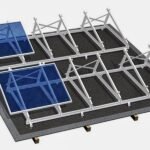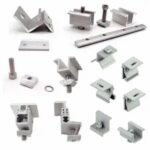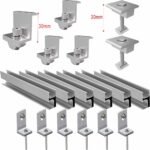Solar panel trackers system:
Solar panel trackers are devices that direct solar panels toward the sun during the day to maximize energy production. There are mainly two types:
- Single-Axis Trackers: These trackers adjust the solar panels to follow the sun’s path along one axis, usually either east to west (horizontal tracking) or up and down (vertical tracking). They can increase energy output by up to 25% compared to fixed panels.
- Dual-Axis Trackers: Dual-axis trackers align solar panels along both horizontal and vertical axes, allowing them to follow the sun’s path more accurately throughout the day. This type of detector can increase the output energy by 45% compared to fixed panels.
Solar Panel Surface Cleaning Devices and Robots :
Solar panel surface cleaning machines and robots are designed to remove dust, dirt, debris and other contaminants from solar panels to maintain their efficiency and performance. Here are some types:
- Automatic cleaning systems: These systems use brushes, wipers or sprayers to automatically clean solar panels. They may be fitted with sensors to detect dust levels and initiate cleaning when needed.
- Robotic cleaners: Robotic cleaners are independent devices equipped with brushes, squeegees or other cleaning mechanisms. They move across the surface of the solar panels and remove dirt and debris. Some models are equipped with sensors and GPS navigation to optimize cleaning routes.
These cleaning devices and robots help maintain optimal energy production from solar panels by ensuring they are free from blockages and contamination.














Solar Cables, Connectors, and Sockets):
Solar cables, connectors, and sockets are essential components in photovoltaic (PV) systems to safely and efficiently connect solar panels, inverters, and other system components. Here are some common types:
- MC4 connectors: MC4 connectors are single contact electrical connectors widely used in PV systems to connect solar panels. They ensure a secure and weatherproof connection, which usually has a male and female connector.
- PV connectors: PV connectors include different types such as MC3, MC4 and TS4 connectors, which are specifically designed for use in solar installations. They come in various sizes and configurations to accommodate different cable sizes and connection needs.
- Solar cables: Solar cables are designed to withstand external conditions and carry electric current produced by solar panels. They are usually UV-resistant, weatherproof, and able to withstand high temperatures and mechanical stress.
- Branch sockets: Branch sockets are used to connect multiple solar panels or strings together, allowing parallel or series connection to the main PV system.
- Terminal blocks: Terminal blocks provide a safe and accessible connection point for connecting cables in a PV system and facilitate easy installation and maintenance.
- Cable Gland: It is used to secure and protect the cables when they enter the enclosures or junction boxes and prevent waterproof sealing and moisture ingress.
These components are very important for the reliable and efficient operation of solar energy systems, making safe electrical connections and protecting against environmental factors.
کابل های خورشیدی، کانکتورها و سوکت ها
(Solar Cables, Connectors, and Sockets) :
Solar cables, connectors, and sockets are essential components in photovoltaic (PV) systems to safely and efficiently connect solar panels, inverters, and other system components. Here are some common types:
- MC4 connectors: MC4 connectors are single contact electrical connectors widely used in PV systems to connect solar panels. They ensure a secure and weatherproof connection, which usually has a male and female connector.
- PV connectors: PV connectors include different types such as MC3, MC4 and TS4 connectors, which are specifically designed for use in solar installations. They come in various sizes and configurations to accommodate different cable sizes and connection needs.
- Solar cables: Solar cables are designed to withstand external conditions and carry electric current produced by solar panels. They are usually UV-resistant, weatherproof, and able to withstand high temperatures and mechanical stress.
- Branch sockets: Branch sockets are used to connect multiple solar panels or strings together, allowing parallel or series connection to the main PV system.
- Terminal blocks: Terminal blocks provide a safe and accessible connection point for connecting cables in a PV system and facilitate easy installation and maintenance.
- Cable Gland: It is used to secure and protect the cables when they enter the enclosures or junction boxes and prevent waterproof sealing and moisture ingress.
These components are very important for the reliable and efficient operation of solar energy systems, making safe electrical connections and protecting against environmental factors.








Metal Structures and Connections for Solar Panels :
Metal structures play an important role in the support and stability of the panels. Here is an overview of the metal structures and fittings used:
- Steel support profiles: Steel support profiles are usually used to provide a strong framework for the installation of solar panels. These profiles are designed to withstand environmental factors and provide long-term support for the panels.
- Metal Construction: Metal structures designed specifically for solar panels provide durability and reliability. These structures are usually made of light steel profiles and provide a solid base for the photovoltaic panels.
- Solar installation structures: There are different types of solar installation structures, including ground, roof and foundation structures. These structures are often made of steel or aluminum and are engineered to hold the solar panels securely in place.
- Metal components: Various metal components such as aluminum, steel and zinc are used in the installation of solar panels. Aluminum and steel are commonly used for racks and frames and provide structural support for the panels.
These metal structures and connections ensure the stability, durability and efficiency of solar panel systems and contribute to their overall performance and longevity.















